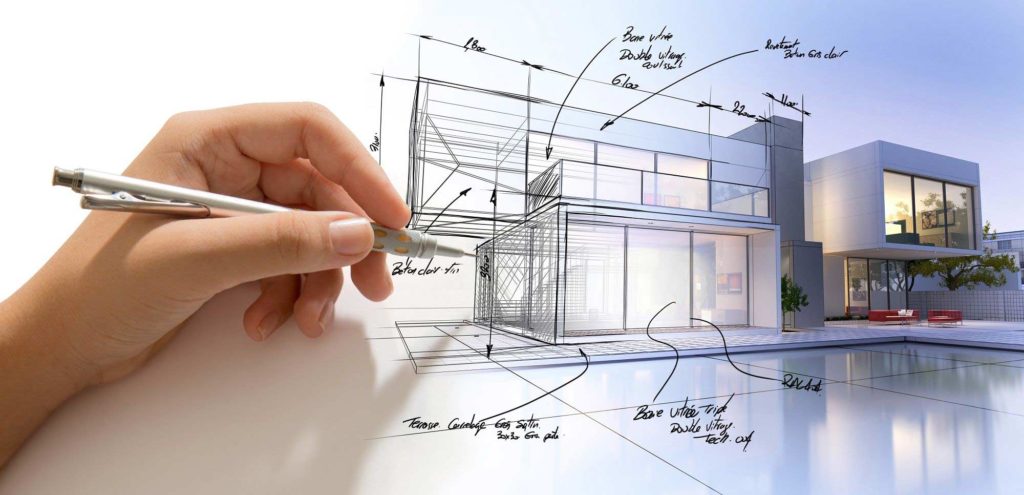Recognizing the Diverse Job Paths Available for Aspiring Architect
As a hopeful Architect, you have a world of profession paths awaiting you. Each path supplies one-of-a-kind obstacles and chances to apply your imagination and technical expertise. Whether you're drawn to standard design or the subtleties of sustainable design, there's a particular niche that aligns with your passions. Recognizing these varied options can form your expert trip, yet which direction will you select to check out initially?
Standard Architecture: Designing Structures and Structures
Traditional design focuses on developing structures and frameworks that blend performance with aesthetic charm. Your designs can show cultural heritage, showcasing regional traditions while fulfilling contemporary needs.
You'll develop abilities in preparing, model-making, and site evaluation, permitting you to visualize and interact your ideas effectively. Involving with customers, you'll need to recognize their vision and convert it right into feasible designs.
In addition, building codes and sustainability methods are vital in your work, ensuring your structures are risk-free and environmentally pleasant. As you grow in your career, you'll locate opportunities in residential, industrial, or perhaps restoration projects, each offering distinct challenges. Welcoming conventional design paves the method for a satisfying career that admires the past while forming the future.
Urban Planning: Forming Communities and Public Spaces
As an aspiring Architect, you can play a necessary function as an urban planner, changing how communities operate and communicate. By employing area involvement techniques, you'll assure that homeowners have a voice in shaping their setting. Plus, integrating sustainable style concepts will certainly aid develop rooms that not just meet today's demands however also secure the future.
Function of Urban Planners
While numerous might consider designers as the sole visionaries behind structures, urban organizers play a necessary role fit the more comprehensive landscape of neighborhoods and public areas. They assess land use, zoning legislations, and neighborhood requires to produce sustainable settings that boost lifestyle. By working together with numerous stakeholders, you'll help design parks, transport systems, and domestic locations that promote social communication and ease of access. Urban organizers also concentrate on environmental factors to consider, guaranteeing that developments integrate environment-friendly spaces and assistance biodiversity. Your experience in spatial style and neighborhood dynamics enables you to visualize future development while preserving social heritage. In this important duty, you'll straight influence how people experience their environments, making every task a possibility for positive modification.
Area Involvement Techniques
Reliable community involvement methods are essential for urban coordinators to ensure that the voices of residents are heard and valued in the planning process. To foster meaningful dialogue, you should prioritize open online forums and workshops where community participants can share their ideas and worries. By proactively incorporating and listening feedback, you'll develop spaces that mirror the community's demands, ultimately leading to even more sustainable and successful urban atmospheres.
Lasting Layout Principles
When designing urban rooms, integrating sustainable design concepts is vital for creating environments that thrive both ecologically and socially. You should begin by concentrating on power effectiveness, using products that minimize waste and advertise recycling. Take into consideration integrating eco-friendly spaces, like parks and gardens, to enhance biodiversity and improve air high quality. Advertising walkability and public transportation can decrease dependence on cars, promoting a much healthier community.
Creating with water preservation in mind is also essential-- think concerning rainfall gardens and absorptive surface areas to handle stormwater. Including neighborhood members during the planning process assurances that the spaces you develop meet their demands and encourage social interaction. By accepting these concepts, you'll add to lively, lasting urban landscapes that benefit every person.

Landscape Style: Creating Sustainable Outdoor Settings
As you explore landscape style, you'll discover essential style principles that develop functional and attractive exterior areas. Sustainable techniques play an essential role in making sure these atmospheres prosper while decreasing ecological influence. Plus, you'll discover a selection of career chances that permit you to make a genuine difference in exactly how individuals connect with nature.
Layout Concepts in Landscape
Recognizing layout concepts in landscape style is vital for producing lasting outside environments that harmonize with nature. You'll need to contemplate aspects like balance, range, and percentage to guarantee your designs feel natural and welcoming. In addition, pay interest to seasonal changes, making with products that complement the surroundings year-round.
Lasting Practices Review
Sustainable practices in landscape design not only concentrate on aesthetic appeals yet additionally focus on ecological health and resource preservation. By integrating indigenous plants, you boost biodiversity and reduce the need for chemical fertilizers and chemicals. Carrying out efficient watering systems aids save water and lessens runoff, securing nearby ecological communities. You can develop spaces that advertise soil wellness, such as exercising and making use of organic products permaculture principles. Furthermore, including eco-friendly framework, like rain yards and permeable pavements, help in stormwater management and minimizes metropolitan warm. When you create exterior atmospheres with sustainability in mind, you add to a much healthier world and offer spaces that cultivate neighborhood connection. Eventually, these techniques ensure your designs profit my blog both individuals and the environment for several years ahead.
Career Opportunities Expedition
With a solid foundation in sustainable practices, landscape architecture uses a variety of occupation paths that allow you to make a meaningful influence on the environment. Urban planners often work together with landscape architects to produce environment-friendly areas in urban settings, improving city livability. If you're enthusiastic regarding education, consider ending up being a landscape style teacher, inspiring future generations.
Sustainable Style: Concentrating On Eco-Friendly Practices
As you discover your occupation in design, welcoming environmentally friendly methods can set you apart in a competitive area. Sustainable style concentrates on creating structures that lessen ecological effect while improving passenger well-being. By integrating eco-friendly products, energy-efficient systems, and sustainable building strategies, you'll add to a greener future.
Start by acquiring knowledge of eco-friendly accreditations like LEED or BREEAM, which can reinforce your qualifications. Take into consideration exactly how natural light, ventilation, and thermal efficiency can enhance design. Collaborate with engineers and environmental specialists to introduce remedies that reduce waste and conserve resources.
Do not fail to remember the value of community participation-- engaging local stakeholders can inspire styles that harmonize with the environment. As clients progressively focus on sustainability, your experience in environment-friendly methods will certainly not just draw in jobs but additionally fulfill your passion for liable design. Accept this critical facet of the occupation, and see your profession flourish.
Historic Conservation: Shielding and Restoring Cultural Heritage
While you begin on your building trip, take into consideration the necessary role of historical conservation in maintaining our social heritage. This area concentrates on the protection and restoration of significant structures, sites, and frameworks that tell the tales of our past. By participating in historical preservation, you'll aid secure the building legacy that forms neighborhood identification.
As a historic preservation Architect, you'll analyze historic relevance and examine the problem of structures. You'll work very closely with conservationists and historians to assure genuine remediation strategies are employed. This occupation path allows you to mix imagination with study, enabling you to develop solutions that value original materials and workmanship.
Your job not just adds to sustainability by reusing existing structures but additionally cultivates a sense of pride within areas. Embracing this course will aid you become a guardian of background, preserving the stories and looks that improve our lives.
Interior Design: Enhancing Indoor Spaces
Historical conservation and indoor style both share a commitment to boosting the developed atmosphere, but they concentrate on different elements. While historical conservation highlights maintaining a framework's cultural and historic value, indoor architecture absolutely nos in on optimizing interior areas for capability and aesthetics.
As a hopeful Architect, you'll discover that interior style enables you to blend creative thinking with technical skills. You'll develop spaces that not just look excellent however also promote comfort and effectiveness. This field involves understanding just how light, shade, and products interact within a space, affecting state of mind and use.
You'll work with different jobs, from residential homes to industrial workplaces, making sure that each atmosphere fulfills the needs of its residents. By prioritizing user experience, you can change interiors right into practical and inspiring rooms, making a considerable influence on exactly how people engage with their environments. Welcome the possibility to enhance interior environments and shape the way individuals live and function.
Industrial Style: Merging Functionality With Looks
Industrial layout plays a necessary function in developing items that seamlessly blend aesthetic appeals with functionality, making sure that what you make use of everyday is not only visually attractive yet likewise functional. As an aspiring Architect, you can immerse yourself in this field, concentrating on designing whatever from furniture to consumer visit electronic devices. Your job involves comprehending customer demands, materials, and manufacturing procedures, enabling you to create innovative options that boost everyday experiences.
In commercial design, you'll frequently work together with marketing professionals, engineers, and makers, making certain that your layouts are not only lovely however likewise practical. This career path uses a vibrant environment where creative go to my site thinking meets usefulness, making it a rewarding selection for architects interested in shaping the products of tomorrow.
Often Asked Questions
What Educational Certifications Do I Required to Come To Be a Designer?
To come to be a designer, you'll require a specialist level in architecture, generally a Bachelor's or Master's. Additionally, you'll have to complete an internship and pass the Architect Enrollment Examination to practice legally.
Exist Accreditation Demands for Various Building Job Paths?
Yes, there're certification demands for various architectural paths. Architect. You'll need to pass examinations, total teaching fellowships, and in some cases go after specialized training, depending on your picked focus, like landscape architecture, metropolitan style, or historic conservation
What Software Skills Are Crucial for Architects Today?

How Can I Gain Practical Experience While Examining Architecture?
You can acquire functional experience by interning at building firms, taking part in layout competitions, offering for neighborhood jobs, or teaming up with classmates on real-world projects. These chances enhance your abilities and construct valuable links in the market.
What Task Opportunities Exist Outdoors Conventional Architecture Firms?
You can discover different work opportunities outside traditional architecture companies, like city preparation, indoor layout, landscape style, construction administration, property development, or perhaps duties in sustainability consulting. Each deals one-of-a-kind obstacles and benefits.
Whether you're attracted to standard style or the subtleties of lasting layout, there's a specific niche that aligns with your interests.When making metropolitan spaces, including lasting style concepts is critical for producing environments that flourish both environmentally and socially.As you discover landscape architecture, you'll uncover essential design principles that create practical and attractive outdoor rooms.Comprehending layout concepts in landscape architecture is vital for producing lasting outside environments that integrate with nature.In industrial style, you'll usually collaborate with makers, marketers, and engineers, making certain that your layouts are not just gorgeous however also feasible.